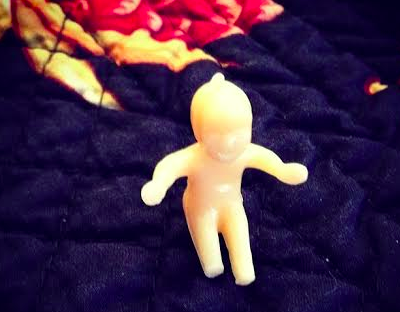By Victoria Hart Glavin of Tiny New York Kitchen

I’m sure you’ve been hearing a lot about King Cake these days, but just what is King Cake anyway? King cakes are a holiday tradition around the world, including the celebration of the Twelfth Night and Carnival. Each community has its own recipe variations and symbolic interpretations. In the United States, a plastic baby is baked inside the cake, and the person who received the slice with the baby in it is said to have good luck and named Queen or King of the party and required to supply the next king cake or host the next party or both. The cake is topped with icing and three colored sugars that represent justice (purple), faith (green), and power (gold). Warning…this is an involved recipe.
INGREDIENTS
- 1/2 Cup Warm Water Which Should Be 105 to 115 Degrees
- 2 Packages Dry Yeast
- 1 Tablespoon Sugar
- 4 to 5 Cups Unbleached Flour
- 1/2 Cup Sugar
- 2 Teaspoons Kosher Salt
- 1 Teaspoon Ground Nutmeg
- 1 Teaspoon Grated Lemon Rind
- 1/2 Cup Warm Milk Which Should Be 105 to 115 Degrees
- 1/2 Cup Melted Unsalted Butter (Cooled)
- 5 Egg Yolks
- 1/2 Cup Chopped Candied Citron
- 1 King Cake Baby (As Shown)
Icing:
- 2 Cups Sifted Powdered Sugar
- 2 Tablespoons Lemon Juice
- 2 Tablespoons Water
- Colored Sugar Crystals (Purple, Green & Gold)
Preheat your oven to 350 degrees. In a small-size bowl combine warm water, yeast, and 1 tablespoon sugar. Mix well and set aside in a warm place for 10 minutes. In a large-size bowl combine 4 cups flour, 1/2 cup sugar, kosher salt, nutmeg, lemon rind, warm milk, cooled melted butter, egg yolks and yeast mixture. Beat until smooth. Turn dough out on a lightly floured surface and knead in enough of the remaining 1 cup flour until dough is no longer sticky. Continue kneading for 10 minutes until dough is smooth and elastic. Place dough in a well-greased bowl and turn once so greased surface is on top. Cover dough with plastic wrap or kitchen towel and let rise in a warm place for 1 1/2 hours until double in bulk. Punch dough down and place on a lightly floured surface. Sprinkle with citron and knead until citron is evenly distributed. Shape dough into a cylinder, about 30 inches long. Place cylinder on a greased baking sheet and shape into a ring. Pinch ends together to seal. Place a well-greased 2 inch coffee can in canter of the ring to keep the shape during baking. Press King Cake Baby into ring from the bottom so that it is completely hidden by the dough. Cover ring with a kitchen towel, and let rise in a warm place for 45 minutes until doubled in bulk. Place in oven and bake for 30 to 35 minutes until golden brown. Remember that each oven heats differently. Remove from oven and remove coffee can immediately. Allow cake to cool for 10 minutes on baking pan. Remove from pan to wire rack to cool completely. To make icing: In a small-size bowl combine powdered sugar, lemon juice, and water. Beat until smooth. Drizzle cake with icing. Sprinkle with sugar crystals by alternating colors. Serve cake and watch who gets the baby! Serves 12
____________
Victoria Hart Glavin has been cooking and writing recipes since she was a teenager. Originally from Nebraska, her appreciation for culinary technique took off when she moved to Lyon, France.
While living in France, Victoria studied French cooking from an expert Lyonnais chef. Victoria learned to love the local culture of preparing and enjoying fresh, seasonal foods. While in France, Victoria experienced the joys of shopping for local produce at the market and preparing fresh foods simply and beautifully in order to enhance the experience of the table. During her time in France, she says she “learned how to squeeze tomatoes at the local market” and “took everything in by osmosis.”
Currently, Victoria creates tasty treats in her tiny kitchen, in New York City, for all to enjoy and on weekends she explores Fairfield County where has a second home. Victoria has shared her recipes with others and now you can enjoy the Tiny New York Kitchen recipe collection, too! Victoria is a member of Culinary Historians of New York and a member of the Association for the Study of Food and Society.
